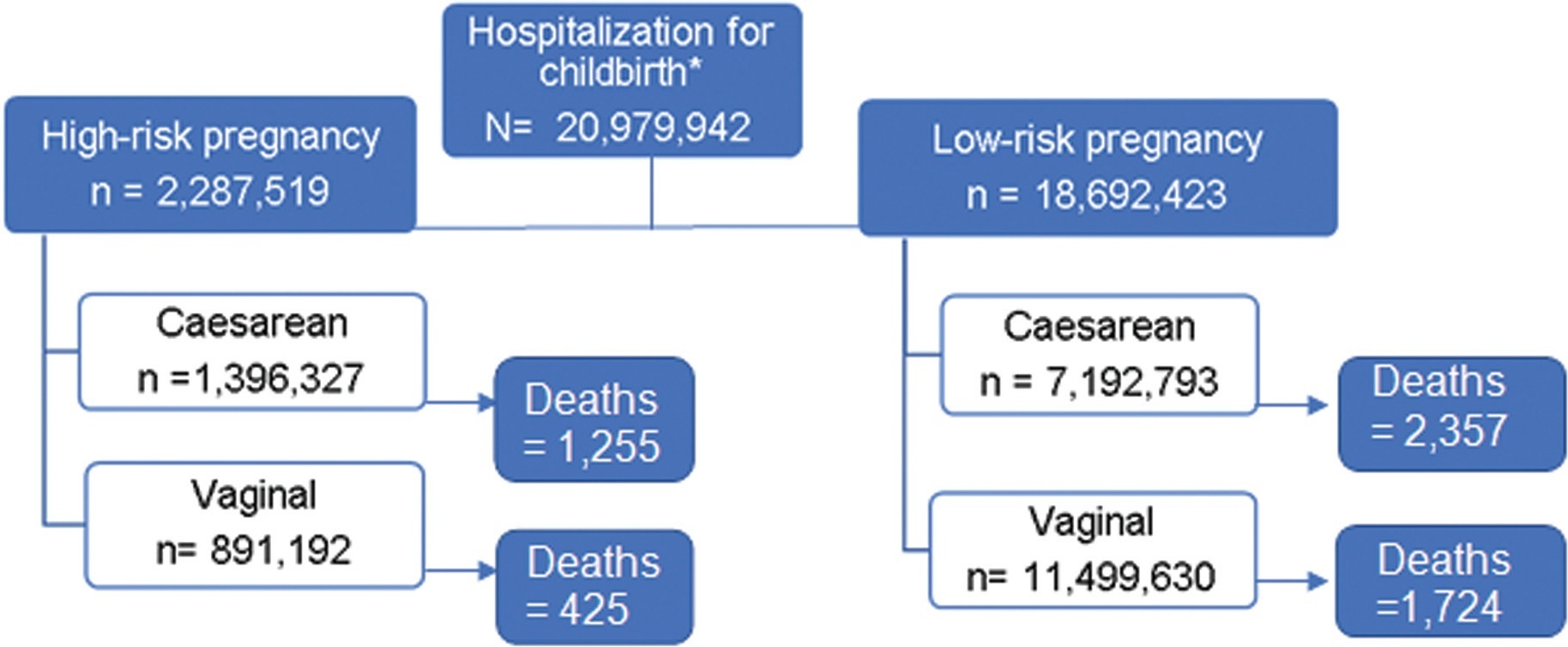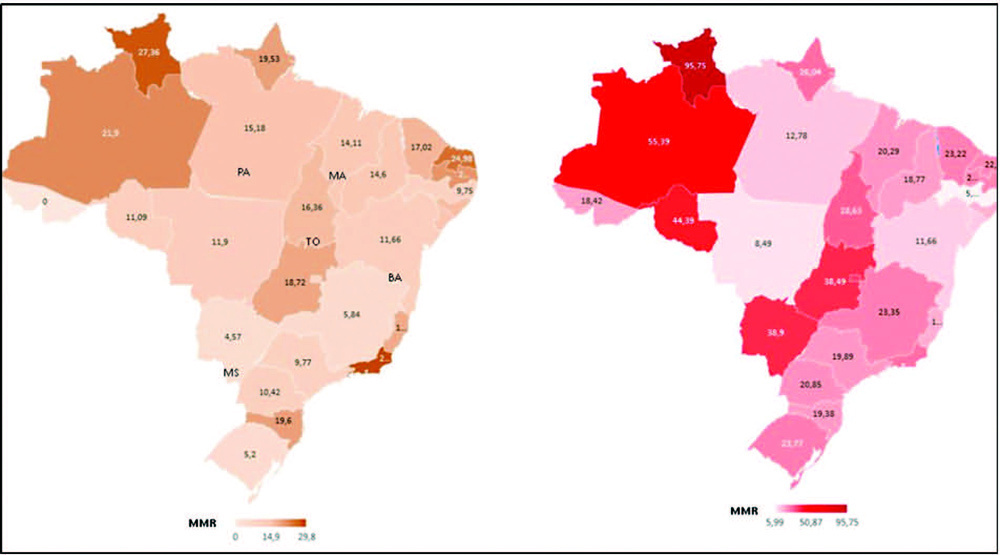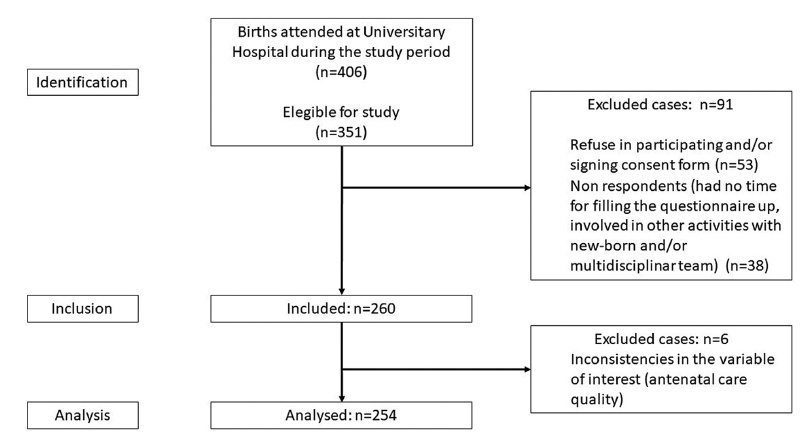Summary
Revista Brasileira de Ginecologia e Obstetrícia. 2022;44(8):740-745
To assess the possible impact of the COVID-19 pandemic on maternal mortality among admissions for childbirth in 2020 in relation of the last 10 years.
An ecological study with pregnant women who underwent hospital births at the Brazilian unified public health service (SUS, in the Portuguese acronym) in Brazil from 2010 to 2020. The mortality among admissions for childbirth was obtained based on the number of admissions for childbirth with reported death as outcome divided by the total number of admissions. The underlying gestational risk and route of delivery were considered based on the national surveillance system. The average mortality for the period between 2010 and 2019 (baseline) was compared with the rate of deaths in 2020 (1st pandemic year); the rate ratio was interpreted as the risk of death in 2020 in relation to the average of the previous period (RR), with 95% confidence intervals (CIs).
In 2020, the 1st year of the COVID-19 pandemic, 1,821,775 pregnant women were hospitalized for childbirth and 651 deaths were reported, which represents 8.7% of the total hospitalizations and 11.3% of maternal deaths between 2010 and 2020. There was an increase in maternal mortality after births in 2020 compared with the average for the period between 2010 and 2019, specially in low-risk pregnancies, both in vaginal (RR = 1.60; 95%CI:1.39–1.85) and cesarean births (RR = 1.18; 95%CI:1.04–1.34).
Maternal mortality among admissions for childbirth according to SUS data increased in 2020 compared with the average between 2010 and 2019, with an increment of 40% in low-risk pregnancies. The increase was of 18% after cesarean section and of 60% after vaginal delivery.

Summary
Revista Brasileira de Ginecologia e Obstetrícia. 2022;44(4):391-397
To determine knowledge, attitude, and preventive (KAP) practices towards the SARS-CoV-2 (COVID-19) pandemic among women in reproductive age seeking to use copper or hormonal intrauterine devices (IUD/LNG-IUS).
We conducted a cross-sectional study in which we applied a questionnaire on 400 women about KAP practices on COVID-19 at the University of Campinas, Campinas, SP, Brazil, from May to August 2020.
The mean (±SD) age of the women was 30.8±7.9 years, and 72.8% of them reported being pregnant at least once. Most women (95%) had heard or read about COVID-19, and their main sources of information were television (91%) and government websites (53%). However, 53% of the women had doubts about the veracity of the information accessed.
Women without a partner and with>12 years of schooling had more information about COVID-19 and on its impact on new pregnancy, and those from high socioeconomic status had a higher chance of maintaining physical distance. Safety, effectiveness, comfort, and absence of hormone in the contraceptive method (in the case of TCu380A IUD) were the main reasons for the participants to seek the service during the pandemic, and the possibility to stop menstrual bleeding was the main reason to choose the LNG-IUS.
Summary
Revista Brasileira de Ginecologia e Obstetrícia. 2022;44(9):871-877
This study aimed to evaluate the diagnostic profile of breast cancer cases during the coronavirus disease 2019 (COVID-19) pandemic compared with the previous year.
It is a retrospective study of cases diagnosed by a reference service in the public health system of Campinas, SP, Brazil. Two periods were analyzed: March to October 2019 (preCOVID period) and March to October 2020 (COVID-period). All women diagnosed during the periods were included. The Chi-Squared or Fisher exact and Mann-Whitney tests were used.
In the preCOVID and COVID periods, breast cancers were diagnosed, respectively, in 115 vs 59 women, and the mean ages at diagnosis were 55 and 57 years (p = 0.339). In the COVID period, the family history of breast cancer was more observed (9.6% vs 29.8%, p < 0.001), cases were more frequently symptomatic (50.4% vs 79.7%, p < 0.001) and had more frequently palpable masses (56.5% vs 79.7%, p = 0.003). In symptomatic women, the mean number of days from symptom to mammography were 233.6 (458.3) in 2019 and 152.1 (151.5) in 2020 (p = 0.871). Among invasive tumors, the proportion of breast cancers in stages I and II was slightly higher in the COVID period, although not significantly (76.7% vs 82.4%, p = 0.428). Also in the COVID period, the frequency of luminal A-like tumors was lower (29.2% vs 11.8%, p = 0.018), of triple-negative tumors was twice as high (10.1% vs 21.6%, p = 0.062), and of estrogen receptor-positive tumors was lower (82.2% vs 66.0%, p = 0.030).
During the COVID-19 pandemic, breast cancer diagnoses were reduced. Cases detected were suggestive of a worse prognosis: symptomatic women with palpable masses and more aggressive subtypes. Indolent tumors were those more sensitive to the interruption in screening.
Summary
Revista Brasileira de Ginecologia e Obstetrícia. 2022;44(6):567-572
To compare death rates by COVID-19 between pregnant or postpartum and nonpregnant women during the first and second waves of the Brazilian pandemic.
In the present population-based evaluation data from the Sistema de Informação da Vigilância Epidemiológica da Gripe (SIVEP-Gripe, in the Portuguese acronym), we included women with c (ARDS) by COVID-19: 47,768 in 2020 (4,853 obstetric versus 42,915 nonobstetric) and 66,689 in 2021 (5,208 obstetric versus 61,481 nonobstetric) and estimated the frequency of in-hospital death.
We identified 377 maternal deaths in 2020 (first wave) and 804 in 2021 (second wave). The death rate increased 2.0-fold for the obstetric (7.7 to 15.4%) and 1.6-fold for the nonobstetric groups (13.9 to 22.9%) from 2020 to 2021 (odds ratio [OR]: 0.52; 95% confidence interval [CI]: 0.47–0.58 in 2020 and OR: 0.61; 95%CI: 0.56– 0.66 in 2021; p < 0.05). In women with comorbidities, the death rate increased 1.7-fold (13.3 to 23.3%) and 1.4-fold (22.8 to 31.4%) in the obstetric and nonobstetric groups, respectively (OR: 0.52; 95%CI: 0.44–0.61 in 2020 to OR: 0.66; 95%CI: 0.59–0.73 in 2021; p <0.05). In women without comorbidities, the mortality rate was higher for nonobstetric (2.4 times; 6.6 to 15.7%) than for obstetric women (1.8 times; 5.5 to 10.1%; OR: 0.81; 95%CI: 0.69–0.95 in 2020 and OR: 0.60; 95%CI: 0.58–0.68 in 2021; p <0.05).
There was an increase in maternal deaths from COVID-19 in 2021 compared with 2020, especially in patients with comorbidities. Death rates were even higher in nonpregnant women, with or without comorbidities.

Summary
Revista Brasileira de Ginecologia e Obstetrícia. 2022;44(2):100-108
In addition to being a medical phenomenon, pandemics affect the individual and society on several levels and lead to disruptions. In the pandemic process, different groups in the population, including pregnant women as a defenseless group, are subjected to psychological threat. The present study aimed to determine the levels of anxiety and depression and related factors in pregnant women during the the coronavirus disease 2019 (Covid-19) pandemic.
The present cross-sectional study was conducted with 269 pregnant women through face-to-face interviews held in Istanbul, Turkey. Regarding the data collection tools, the Cronbach α reliability coefficient was of 0.90 for the Beck Anxiety Inventory, and of 0.85 for the Beck Depression Inventory.
Among the participating pregnant women, 30.5% had mild, 17.5% had moderate, and 5.9% had severe anxiety symptoms, whereas 35.3% had mild, 16.7% had moderate, and 2.2% had severe depression symptoms. We found that those who were concerned about their health had 5.36 times (p=0.04) more risk of developing anxiety, and 4.82 times (p=0.01) more risk of developing depression than those who were not concerned. Those who had a history of psychiatric disease had 3.92 times (p=0.02) more risk of developing anxiety than those without it.
We determined that about half of the pregnant women included in the study had some degree of anxiety and depression during the COVID-19 pandemic. The risk factors for anxiety and depression among the pregnant women were determined as smoking, concerns about health and getting infectedwith the coronavirus, history of psychiatric disease, and undergoing regular antenatal care.
Summary
Revista Brasileira de Ginecologia e Obstetrícia. 2022;44(4):398-408
The present study aimed to evaluate the antenatal care adequacy for women who gave birth at the University Hospital of Santa Catarina in Florianopolis (Brazil) during the COVID-19 pandemic, and to evaluate the association of adequacy with sociodemographic, clinical, and access characteristics.
Data were collected between October and December 2020, including 254 patients who delivered in the University Hospital from Federal University of Santa Catarina and answered our questionnaires. Additional data were obtained from patients’ antenatal booklets. Antenatal care was classified as adequate, intermediate, or inadequate according to the number of appointments, gestational age at the beginning of follow-up, and tests results. We carried out a descriptive statistical analysis and a bivariate/with odds ratio analysis onmaternal sociodemographic, clinical and health access variables that were compared with antenatal adequacy.
Antenatal care was considered adequate in 35.8% of cases, intermediate in 46.8%, and inadequate in 17.4%. The followingmaternal variables were associated with inadequate prenatal care (intermediate or inadequate prenatal care): having black or brown skin colour, having two or more children, being of foreign nationality, not being fluent in Portuguese, and using illicit drugs during pregnancy; the clinical variables were more than 6 weeks between appointments, and not attending high-risk antenatal care; as for access, the variables were difficulties in attending or scheduling appointments, and attending virtual appointments only.
In a sample of pregnant women from a teaching hospital in Florianópolis during the COVID-19 pandemic, antenatal care was considered adequate in 35.8%, intermediate in 46.8%, and inadequate in 17.4% of cases.

Summary
Revista Brasileira de Ginecologia e Obstetrícia. 2022;44(5):532-539
The present article seeks to consolidate existing knowledge on breastfeeding during the SARS-CoV-2 pandemic.
Articles from 2020 and 2021 collected from the PubMed, CAPES, Virtual Health Library, Google Scholar, SciELO, and UpToDate databases were analyzed. Books and government documents published in the last decade (2010-2020) were also consulted.
Sixteen works were used in the present study. The date of publication and discussion of SARS-CoV-2 transmission through breastmilk were the inclusion criteria. Thus, articles containing repeated information or with no relevance to add to the production were excluded. Data collection comprised critical reading and synthesis of the main information obtained on the subject, which were performed for the preparation of the present study. The research took place in the period from March 27 to April 2, 2021.
Breast milk has diverse benefits for both the nursing mother and the infant. The presence of viral RNA by real-time polymerase chain reaction (RTPCR) in milk from disease-positive mothers has been detected in a few cases, and infant infections in these conditions suggest oral transmission of maternal or third-party origin. The virulence of the novel coronavirus in human milk is not confirmed, while significant amounts of exclusive antibodies are.
Lactation in the context of COVID-19 has shown greater benefits than risks of vertical transmission. Therefore, it should be encouraged when possible.
Summary
Revista Brasileira de Ginecologia e Obstetrícia. 2022;44(3):311-318
The present article presents a literature review concerning the microbiota of breast milk and the influence of epigenetics in the susceptibility to COVID-19.
A literature review.
Breastfeeding transfers microbiota, nutrients, diverse white blood cells, prebiotics, hormones, and antibodies to the baby, which provide short- and longterm immunological protection against several infectious, gastrointestinal, and respiratory illnesses. The little evidence available shows that breast milk very rarely carries the SARS-CoV-2 virus, and even in those cases, it has been discarded as the source of contagion.
The reviewed studies show evidence of a beneficial effect of breastfeeding and highlights its importance on the current pandemic due to the immune reinforcement that it provides. Breastfed individuals showed better clinical response due to the influence on the microbiota and to the nutritional and immune contribution provided by breast milk, compared with those who were not breastfed.